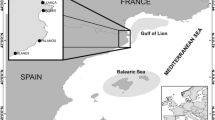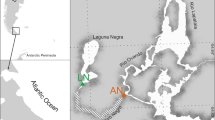Abstract
A population of Galaxias maculatus, a native species in southern South America, living under cold-temperate conditions (0°C water temperature with an ice layer covering the stream during the coldest days) and 7 h of light in winter undergoes high energetic demands in the population studied. We analyzed the energy density of gonads, liver, fat and muscle, through calorimetry for the first time in this species. Energy density of fat and liver were extremely high (34.77–56.52 and 29.54–40.77 kJ/g respectively). While perivisceral fat reserves were likely used for overwintering, liver and muscle reserves were used for reproduction. High energy densities were also found in gonads (27.76 kJ/g in ovaries and 25.84 kJ/g in testes). High investment in gonads of males suggests the presence of sperm competition. The temporal variation of the energy content of gonads, liver, fat and muscle indicates that the allocation of energy occurs by the internal transference of energy between organs and tissues.



Similar content being viewed by others
References
Adams SM, McLean RB, Parrotta JA (1982) Energy partitioning of largemouth bass under conditions of seasonally fluctuating prey availability. Trans Am Fish Soc 111:549–558
Beamish RJ, Bouillon DR (1995) Marine fish production trends off the Pacific coast of Canada and the United States. In: Beamish RJ (ed) Climate change and northern fish populations. Canadian Special Publication in Fisheries and Aquatic Sciences 121, Ottawa, pp 585–591
Booth DJ, Keast JA (1986) Growth energy partitioning by juvenile bluegill sunfish, Lepomis macrochirus Rafinesque. J Fish Biol 28:37–45
Boy CC, Morriconi E, Calvo J (2007) Reproduction in puyen, Galaxias maculatus (Pisces: Galaxiidae) in the southernmost extreme of distribution. J Appl Ichthyol 23:547–554
Bunnell DB, Thomas SE, Stein RA (2007) Prey resources before spawning influence gonadal investment of female, but not male, white crappie. J Fish Biol 70:1838–1854
Calow P (1985) Adaptive aspect of energy allocation. In: Tyler P, Calow P (eds) Fish energetics: new perspectives. Croom Helm, London, pp 13–31
Ciancio JE, Pascual M (2006) Energy density of freshwater Patagonian organisms. Ecol Austral 16:91–94
Clarke A (1983) Life in cold water: the physiological ecology of polar marine ectotherms. Oceanogr Mar Biol 21:341–453
Cussac VE, Ortubay S, Iglesias G, Milano D, Lattuca ME, Barriga JP, Battini M, Gross M (2004) The distribution of South American galaxiid fishes: the role of biological traits and post-glacial history. J Biogeogr 31:103–121
Eliassen JE, Vahl O (1982) Seasonal variations in biochemical composition and energy content of liver, gonad and muscle of mature and immature cod, Gadus morhua (L.) from Balsfjorden, northern Norway. J Fish Biol 20:707–716
Fernández DA, Lattuca ME, Boy CC, Pérez AF, Ceballos SG, Vanella FA, Morriconi E, Malanga GF, Aureliano DR, Rimbau S, Calvo JC (2008) Energy density of Sub-Antarctic fishes from Beagle Channel. Fish Physiol Biochem doi:10.1007/s10695-008-9234-1
Finstad AG, Ugedal O, Forseth T, Næsje T (2004) Energy related juvenile winter mortality in a northern population of Atlantic salmon, Salmo salar L. Can J Fish Aquat Sci 61:2358–2368
Foltz JW, Norden CR (1977) Seasonal changes in food consumption and energy content of smelt (Osmerus mordax) in Lake Michigan. Trans Am Fish Soc 106:230–234
Gardiner WR, Geddes P (1980) The influence of body composition on the survival of juvenile salmon. Hydrobiologia 69:67–72
Hunter JR, Leong R (1981) The spawning energetics of female northern anchovy Engraulis mordax. Fish Bull 79:215–230
Huntingford FA, Chellappa S, Taylor AC, Strang RHC (2001) Energy reserves and reproductive investment in male three-spined sticklebacks, Gasterosteus aculeatus. Ecol Freshw Fish 10:111–117
Iturraspe R, Sottini R, Schroeder C, Escobar J (1989) Hidrología y variables climáticas del Territorio de Tierra del Fuego. Información Básica. Contribución Científica Centro Austral de Investigaciones Científicas (CADIC), Ushuaia
Jobling M (1995) Fish bioenergetics: fish and fisheries. Chapman & Hall, London
Jonsson B, Jonsson N (2005) Lipid energy reserves influence life-history decision of Atlantic salmon (Salmo salar) and brown trout (S. trutta) in fresh water. Ecol Freshw Fish 14:296–301
Kamler E, Krasicka B, Rakusa-Suszczewski S (2001) Comparison of lipid content and fatty acid composition in muscle and liver of two notothenioid fishes from Admiralty Bay (Antarctica): an ecophysiological perspective. Polar Biol 24:735–743
Lucas A (1996) Bioenergetics of aquatic animals. Taylor & Francis, London
Lumb CE, Johnson TB, Andrew Cook HA, Hoyle JA (2007) Comparison of lake whitefish (Coregonus clupeaformis) growth, condition, and energy density between Lakes Erie and Ontario. J Great Lakes Res 33:314–325
Luzzana U, Serrini G, Moretti VM, Grimaldi P, Paleari MA, Valfré F (1996) Seasonal variations in fat content and fatty acid composition of male and female coregonid ‘bondella’ from Lake Maggiore and landlocked shad from Lake Como (Northern Italy). J Fish Biol 48:352–366
McDowall RM (1968) Galaxias maculatus (Jenyns), the New Zealand whitebait. Fish Res Bull 2:1–84
Miranda LE, Hubbard WE (1994) Length dependent winter survival and lipid composition of age-0 largemouth bass in Bay Springs Reservoir, Mississipi. Trans Am Fish Soc 123:80–87
Montecchia CL, Crupkin M, Trucco RE (1990) Seasonal variations in biochemical and physicochemical properties of actomyosin and energy content of the liver, gonads and muscle of mature Argentine hake, Merluccius hubbsi Marini. J Fish Biol 37:837–843
Newsome GE, Leduc G (1975) Seasonal changes of fat content in the yellow perch (Perca flavescens) of two Laurentian lakes. J Fish Res B Can 32:2214–2221
Paul A, Paul J (1999) Energy content of whole body, ovaries and ova, of pre-spawning Pacific herring. Alaska Fish Res Bull 6:29–34
Paul AJ, Paul JM, Smith RL (1998) Seasonal changes in whole-body energy content and estimated consumption rates of age 0 walleye pollock from Prince William Sound, Alaska. Estuar Coast Shelf Sci 47:251–259
Post JR, Evans DO (1989) Size dependent overwintering mortality of young-of-the-year yellow perch (Perca flavescens): laboratory, in situ enclosure, and field experiments. Can J Fish Aquat Sci 46:1958–1968
Ryan PA (1982) Energy contents of some New Zealand freshwater animals. N Z J Mar Fresh 16:283–287
Sibly RM, Calow P (1986) Physiological ecology of animals. Blackwell Scientific, Oxford
Smith RL, Paul AJ, Paul JM (1990) Seasonal changes in energy and the energy cost of spawning in Gulf of Alaska Pacific cod. J Fish Biol 36:307–316
Sokal RR, Rohlf FJ (1995) Biometry. Freeman and Company, New York
Tierney M, Hindell M, Goldsworthy S (2002) Energy content of mesopelagic fish from Macquarie Island. Antarct Sci 14:225–230
van de Putte A, Flores H, Volckaert F, van Franeker JA (2006) Energy content of Antarctic mesopelagic fishes: implications for the marine food web. Polar Biol 29:1045–1051
Vanella FA, Calvo J, Morriconi ER, Aureliano DR (2005) Somatic energy content and histological analysis of the gonads in Antarctic fish from the Scotia Arc. Sci Mar 69:305–316
Vladic TV, Afzelius BA, Bronnikov GE (2002) Sperm quality as reflected through morphology in salmon alternative life histories. Biol Reprod 66:98–105
Waters JM, Burridge CP (1999) Extreme intraspecific mitochondrial DNA sequence divergence in Galaxias maculatus (Osteichthys:Galaxiidae), one of the world’s most widespread freshwater fish. Mol Phylogenet Evol 11:1–12
Zar JH (1984) Biostatistical analysis. Prentice-Hall International Editions, New Jersey
Acknowledgments
We thank the Administración de Parques Nacionales, Sonia Rimbau, Daniel Aureliano, Marcelo Gutiérrez, Sheryl Macnie, Natalie Goodall, Luciana Acuña, Adrián Ayala, Dana González, Eugenia Di Fiori, Diana Anibaldi and Germán Crespo. This research was supported by: CONICET (PIP 2944, PIP 6187), the Administración de Parques Nacionales and the Universidad Nacional de la Patagonia San Juan Bosco.
Author information
Authors and Affiliations
Corresponding author
Rights and permissions
About this article
Cite this article
Boy, C.C., Pérez, A.F., Fernández, D.A. et al. Energy allocation in relation to spawning and overwintering of a diadromous Puyen (Galaxias maculatus) population in the southernmost limit of the species distribution. Polar Biol 32, 9–14 (2009). https://doi.org/10.1007/s00300-008-0495-z
Received:
Revised:
Accepted:
Published:
Issue Date:
DOI: https://doi.org/10.1007/s00300-008-0495-z




